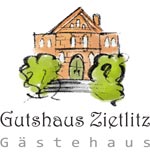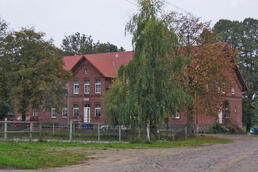Manor House Helpt
In 1455, Helpt had been feoffed to the Bredow family. The property was later acquired by the Duke following the extinction of the family line.
The Duke made it a fiefdom for the needy, and the last beneficiary was Captain Jürgen of Mecklenburg. In 1665, he pledged his land to Henning von Oertzen. In 1694, the Oertzens were forced to pledge Helpt for 20 years. In 1715, Henning von Oertzen was able to redeem the estate. In 1753, it was sold to Captain Lucius Arnold von Rhaden. In 1782, the estate was acquired by Otto Ulrich von Dewitz. In 1865, Ulrich Otto (the third) von Dewitz sold Helpt to Friedrich Adolph Diedrich. He built and renovated the estate in the 1870s. In 1884, he also built the 11-storey manor house with the red clinkers and a rubblestone foundation. His son, Otto Balthasar von Dewitz, sold the estate with the two predecessor buildings to Dr. jur. Hans Bodo, Baron of Bodenhausen, in 1911. The estate was inherited by his son Kraft Eberhard, followed by his grandson Bodo Eberhard, who was also the last lord at Helpt. In the 19th century, the management of the property also discovered the ruins of the medieval castle of Helpt for commercial use. The lower floor was refurbished with a brick vault, filling shafts, ventilation hatches, and door openings on both sides and was used as a potato cellar until the 1950s.
After the stores were no longer needed, sheds and small stables were built on the castle hill. In the mid-1990s, the original castle hill and the ice cellar were restored. A children's home group organized by the International Federation for Social Work was set to move into the manor house.



